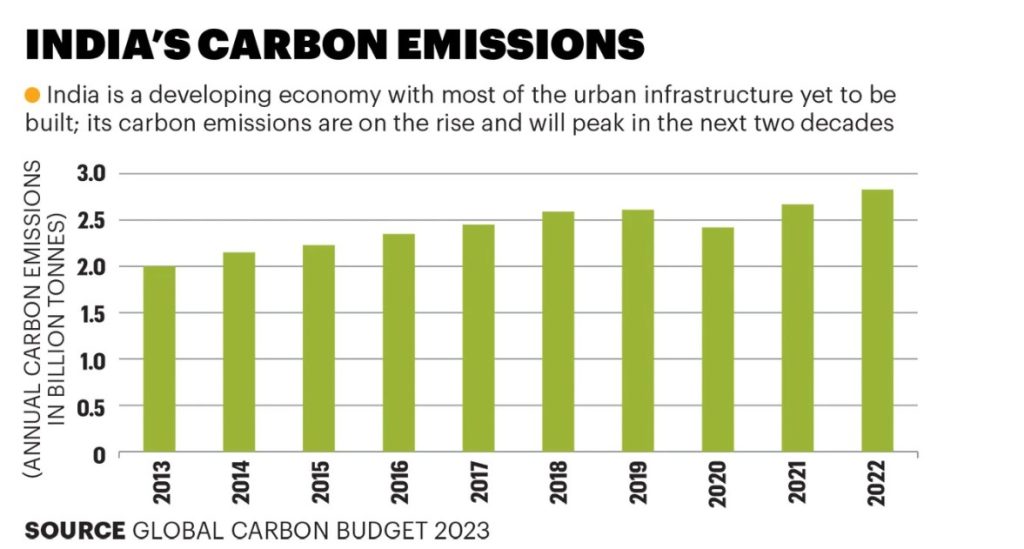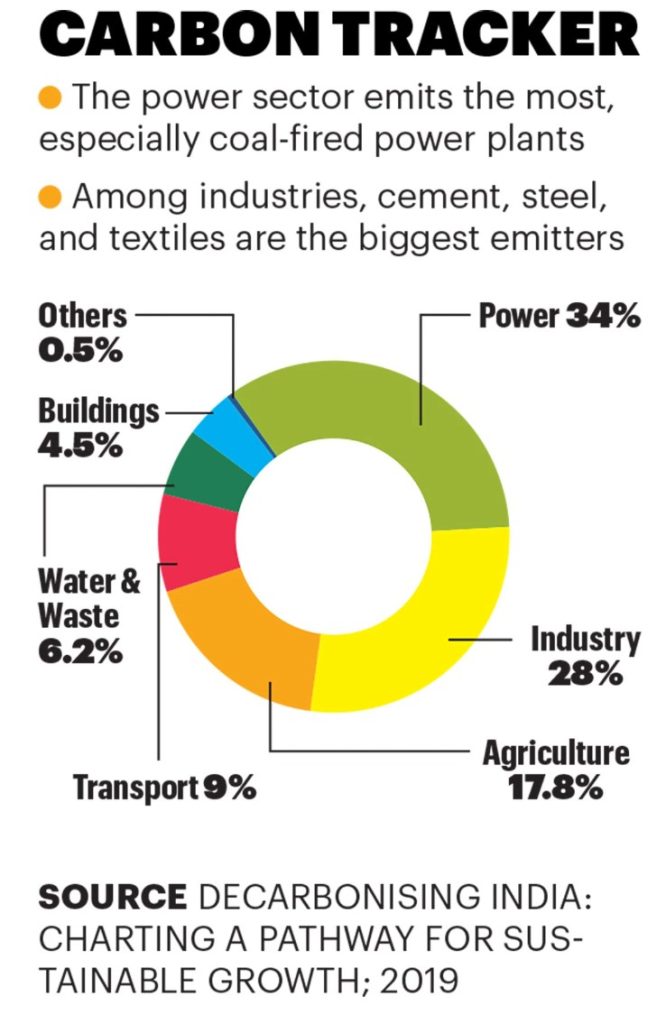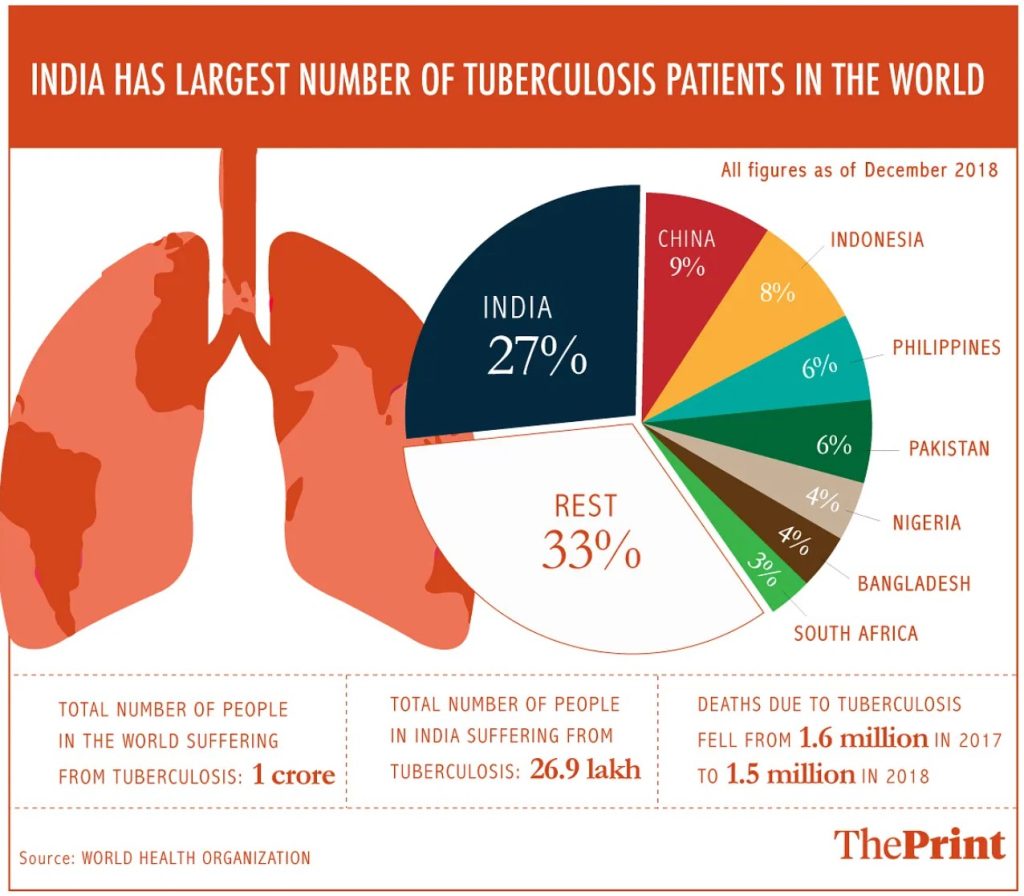CONTENTS
- Establishing a Carbon Market
- Sharpening India’s Anti-Tuberculosis Fight
Establishing a Carbon Market
Context:
In her Budget speech, the Finance Minister indicated that industries with high pollution levels, such as iron, steel, and aluminium, will need to meet specific emission targets. She stated, “A roadmap will be developed to transition ‘hard-to-abate’ industries from energy efficiency targets to emission targets. Regulations will be introduced to shift these industries from the current ‘Perform, Achieve, and Trade‘ (PAT) scheme to the ‘Indian Carbon Market’ framework.”
Relevance:
GS3- Environmental Pollution and Degradation
Mains Question:
Climate change is not about equity concerns alone, but also about searching for viable options to move away from excessive dependence on fossil fuel. Analyse. (10 Marks, 150 Words).

PAT vs. Emissions Trading:
- The Bureau of Energy Efficiency defines PAT as a regulatory tool aimed at reducing specific energy consumption in energy-intensive sectors. It incorporates a market-based mechanism that certifies and trades excess energy savings.
- PAT focuses on achieving energy efficiency, meaning that firms aim to produce a given output using no more than a specified amount of energy.
- This system does not cap total energy use, allowing firms producing more steel, for example, to consume more fuel while still being considered energy-efficient. Successful firms earn credits or certificates that they can trade.
- In contrast, emissions trading, often referred to as cap and trade, is a market-based approach to controlling pollution through economic incentives for reducing emissions.
- Unlike energy efficiency, which is based on relative standards, emissions trading sets absolute limits, or caps, on emissions.
- The Finance Minister’s announcement highlights that for India, a developing country, climate change is not just about equity but also about finding sustainable ways to reduce reliance on fossil fuels.
Decarbonizing Various Sectors:

- Over the past 15 years, India has been working to decarbonize various sectors to meet its development goals, including poverty reduction and providing affordable, reliable energy.
- India participated in the Clean Development Mechanism under the Kyoto Protocol, which allowed industrialized countries to engage in climate mitigation projects in developing nations, earning certified emission reduction units for trade. By 2011, India became the largest supplier of these units globally after China.
- To further this effort, India launched the PAT scheme in 2012 as part of its National Mission for Enhanced Energy Efficiency, one of eight missions under the National Action Plan on Climate Change.
- Given India’s need for iron and steel to support industrialization and meet the growing demand for housing in urban areas, emissions from these sectors significantly contribute to climate change.
- In the context of achieving Net Zero Emissions by 2050, the International Energy Agency (IEA) notes in a policy brief that the likelihood of currently planned iron and steel projects reaching net zero emissions is very low.
Carbon Market Mode:
- In international law, obligations related to climate change mitigation are considered due diligence obligations or obligations of conduct. This means that countries are required to make their best possible efforts to combat climate change.
- An example of such an obligation is the nationally determined contributions (NDCs) central to the Paris Agreement of 2015.
- It is reasonable for India to refine its existing PAT scheme or develop its version of a carbon market within the framework of its NDCs. India’s NDC includes eight targets, two of which pertain to the energy sector.
- The first target is to reduce the emissions intensity of its GDP by 45% from 2005 levels by 2030. The second target is to achieve around 50% of cumulative electric power capacity from non-fossil fuel sources by 2030, contingent on international finance and technology transfer.
- Given that India’s NDC does not require binding greenhouse gas reductions relative to a baseline year, the country is likely to create its own version of a carbon market, distinct from the European Union Emissions Trading System (ETS).
- India has not formally adopted the ETS and has resisted mandatory emission cuts, as such measures would currently conflict with its development priorities.
- The 2021 draft blueprint by the Bureau of Energy Efficiency outlines two mechanisms: in the first phase, a voluntary market supported by a domestic project-based offset scheme (carbon offset mechanism); and in the second phase, a compliance market with mandatory participation for regulated entities (carbon credits trading mechanism).
- According to an International Energy Agency (IEA) policy brief, this will involve updating emissions measurement methodologies to support the launch of a domestic carbon credits trading scheme by 2026, which will include the iron and steel sector, alongside other industries such as petrochemicals, chemicals, and aluminium.
Conclusion:
India’s effort to establish a carbon market tailored to its needs underscores that climate change discussions must go beyond equity concerns and consider broader socioeconomic priorities.
Sharpening India’s Anti-Tuberculosis Fight
Context:
The widespread presence of tuberculosis (TB) throughout history and literature highlights how the disease has afflicted generations worldwide and remains a significant issue today. India accounts for over a quarter of the global TB burden. Strong political will in India has contributed to substantial progress in combating the disease. However, as the nation strives toward TB elimination—a goal emphasized by the Prime Minister—there is a need to innovate and utilize proven technologies and tools.
Relevance:
GS2- Health
Mains Question:
Comment upon the continued prevalence of TB in India despite the progress made here and there. With the availability of game-changing new treatments, India must recast its TB-elimination programmes. Discuss. (15 Marks, 250 Words).
TB in India:

The India TB Report 2024:
- The report reveals a decrease in the mortality rate due to Tuberculosis (TB), from 28 per lakh population in 2015 to 23 per lakh population in 2022.
- Government health centers continue to report the majority of TB cases, though there has been an increase in notifications from the private sector.
- In 2023, about 33% or 8.4 lakh of the 25.5 lakh TB cases were reported by the private sector, a significant rise compared to the 1.9 lakh cases reported by the private sector in 2015, which serves as the baseline year for the disease elimination program.
- The estimated incidence of TB in 2023 slightly increased to 27.8 lakh from 27.4 lakh in the previous year.
- The mortality rate due to TB remained constant at 3.2 lakh.
- India’s TB mortality declined from 4.94 lakh in 2021 to 3.31 lakh in 2022.
- India achieved its 2023 goal of initiating treatment for 95% of patients diagnosed with TB.
Treatment Regimens and Challenges:
- In 2023, efforts to address the challenge of ‘missed’ TB cases led to the diagnosis of 2.51 million TB patients, reflecting improved case-finding initiatives.
- One immediate priority should be the adoption of new, shorter treatment regimens for drug-resistant TB.
- It is promising to hear that India will soon introduce the World Health Organization (WHO)-recommended shorter regimen for drug-resistant TB.
- Currently available regimens are long and difficult, requiring patients to take 13 to 14 tablets daily for the shorter nine to 11-month regimen or four to five tablets daily for the longer 18 to 24-month regimen.
- This treatment is both physically and mentally exhausting, with severe side effects such as hearing loss and even psychosis.
- Additionally, the prolonged nature of the treatment, which necessitates regular visits to a TB clinic for nearly two years, often results in job loss, pushing many families into poverty.
- In 2022, WHO recommended the shorter, safer, and more effective BPaL/M regimens for all drug-resistant TB patients, supported by recent data showing higher efficacy and better patient compliance.
- With only three to four tablets daily, patients can complete treatment within six months, with minimal side effects.
- The success rate of this regimen is significantly higher—89% compared to the 68% success rate reported in India’s 2023 TB Report.
- Due to its effectiveness, nearly 80 countries have already procured the BPaL/M regimen, with about 20 of the highest-burden countries already implementing it.
- Research suggests that adopting this regimen could reduce treatment costs by 40% to 90%, with potential global savings of around $740 million (approximately ₹6,180 crore) annually.
- This regimen offers a more effective and safer solution for treating drug-resistant TB, and it is crucial to expedite access to this treatment for all eligible patients across India.
Maximizing the Benefits of New Treatments:
- The next challenge is how to diagnose more people with TB so they can access these transformative new treatments. The key lies in ensuring quick and efficient screening and testing to minimize delays in accurate diagnosis.
- This requires a proactive approach. It’s time to modernize and utilize health data, including GIS mapping, to identify vulnerable populations, such as those with comorbidities (e.g., malnutrition, diabetes, HIV), former COVID-19 patients, and at-risk groups in slums, prisons, or among the homeless.
- By conducting targeted, multi-disease screening drives, we can detect TB cases early, even in individuals without typical symptoms.
- Recent evidence shows that many people with pulmonary (lung) TB may not display recognizable symptoms like cough, fever, weight loss, or night sweats.
- The National TB Prevalence Survey (2019-21) underscores the importance of chest X-rays, which identified 42.6% of cases that would have otherwise been missed.
- Using advanced technology, portable X-ray machines equipped with AI-driven tools can significantly reduce diagnostic delays, particularly in remote and underserved areas.
- Moreover, it’s essential to expand the use of rapid molecular tests instead of less sensitive microscopy methods for faster detection and drug resistance profiling. This shift is vital for promptly identifying TB cases and determining the appropriate treatment.
Conclusion:
In summary, by proactively identifying at-risk populations and investing in and leveraging advanced diagnostic technologies, we can improve TB detection rates, reduce delays, and enhance treatment outcomes. As we work toward eliminating tuberculosis and making our country TB-free, prioritizing these crucial areas will be an investment in a healthier future for everyone.




